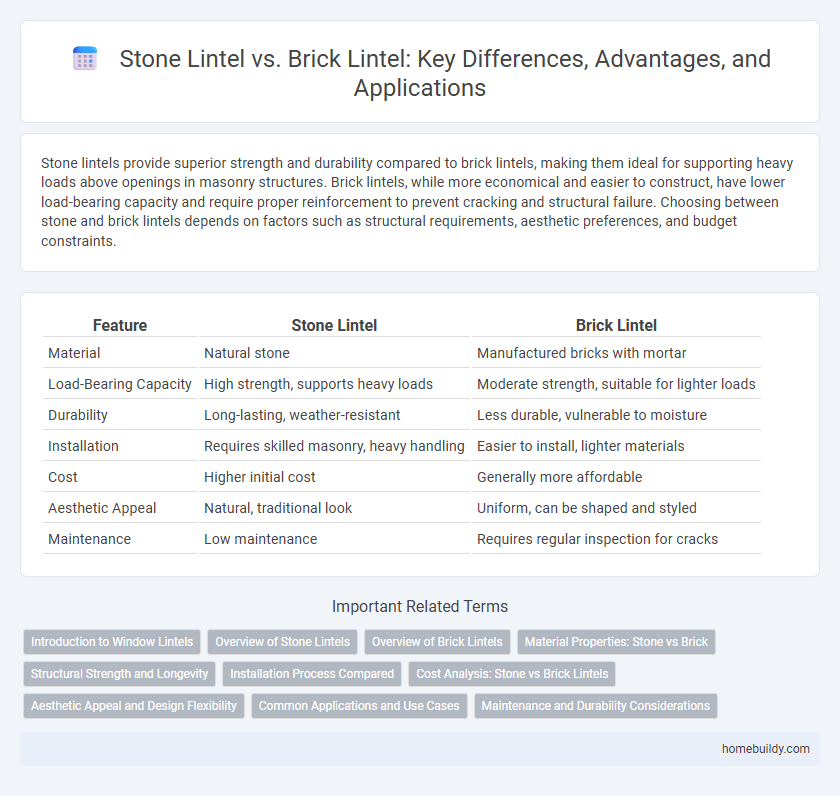Stone lintels provide superior strength and durability compared to brick lintels, making them ideal for supporting heavy loads above openings in masonry structures. Brick lintels, while more economical and easier to construct, have lower load-bearing capacity and require proper reinforcement to prevent cracking and structural failure. Choosing between stone and brick lintels depends on factors such as structural requirements, aesthetic preferences, and budget constraints.
Table of Comparison
| Feature | Stone Lintel | Brick Lintel |
|---|---|---|
| Material | Natural stone | Manufactured bricks with mortar |
| Load-Bearing Capacity | High strength, supports heavy loads | Moderate strength, suitable for lighter loads |
| Durability | Long-lasting, weather-resistant | Less durable, vulnerable to moisture |
| Installation | Requires skilled masonry, heavy handling | Easier to install, lighter materials |
| Cost | Higher initial cost | Generally more affordable |
| Aesthetic Appeal | Natural, traditional look | Uniform, can be shaped and styled |
| Maintenance | Low maintenance | Requires regular inspection for cracks |
Introduction to Window Lintels
Stone lintels offer superior load-bearing capacity and durability, making them ideal for supporting heavy masonry above window openings. Brick lintels provide a cost-effective and aesthetically cohesive solution, especially for structures with matching brickwork, though they generally require reinforcement for added strength. Both types are essential structural components designed to distribute weight and prevent sagging or cracking around windows.
Overview of Stone Lintels
Stone lintels are solid structural elements typically made from durable natural stones such as granite, limestone, or sandstone, providing strong support above window openings. Their inherent compressive strength and resistance to weathering make them suitable for load-bearing applications, especially in traditional masonry construction. Unlike brick lintels, stone lintels require precise cutting and fitting but offer greater longevity and minimal maintenance due to their robust material properties.
Overview of Brick Lintels
Brick lintels consist of horizontal layers of bricks arranged to span openings such as windows and doors, providing support by distributing loads to the adjacent walls. Unlike stone lintels that rely on solid, monolithic blocks, brick lintels utilize the compressive strength and bonding patterns of multiple bricks, often reinforced with steel bars and mortar for added stability. Brick lintels offer flexibility in design and are cost-effective, making them widely used in modern masonry construction where structural integrity and aesthetic integration are essential.
Material Properties: Stone vs Brick
Stone lintels possess superior compressive strength and durability compared to brick lintels, making them ideal for supporting heavier loads and withstanding environmental stresses. Brick lintels, while more flexible and easier to shape, have lower tensile strength and are more susceptible to weathering and cracking over time. The density and hardness of stone provide enhanced longevity, whereas brick lintels require more maintenance to preserve structural integrity.
Structural Strength and Longevity
Stone lintels offer superior structural strength due to their high compressive strength and resistance to weathering, making them ideal for heavy load-bearing applications. Brick lintels, while more versatile and easier to shape, generally have lower load capacity and may require reinforcement such as steel bars to achieve similar durability. Over time, stone lintels typically demonstrate greater longevity and minimal maintenance compared to brick lintels, which can be prone to cracking and degradation under stress or moisture exposure.
Installation Process Compared
Stone lintels require precise cutting and heavy lifting equipment during installation, making the process labor-intensive and time-consuming compared to brick lintels. Brick lintels, constructed by layering bricks with mortar directly on-site, allow for easier handling and faster installation without specialized tools. The structural support in stone lintels depends on accurate placement of heavy units, while brick lintels rely on the bonding strength of mortar to achieve stability.
Cost Analysis: Stone vs Brick Lintels
Stone lintels generally incur higher initial costs due to material expenses and specialized labor requirements, whereas brick lintels offer a more cost-effective solution with readily available materials and simpler installation. Maintenance and durability factors may influence long-term expenses, with stone lintels typically requiring less frequent repairs compared to brick lintels that can be prone to weathering and cracking. The choice between stone and brick lintels depends on budget constraints, aesthetic preferences, and structural demands of the construction project.
Aesthetic Appeal and Design Flexibility
Stone lintels offer a timeless and elegant aesthetic, enhancing architectural character with their natural textures and rich color variations. Brick lintels provide greater design flexibility, allowing for diverse patterns and integration with brickwork facades to achieve cohesive visual appeal. Choosing between stone and brick lintels depends on desired aesthetic outcomes and the need for customization in building design.
Common Applications and Use Cases
Stone lintels are commonly used in traditional or heritage buildings due to their durability and aesthetic appeal, often supporting heavier masonry walls or large openings like arches and doorways. Brick lintels are frequently employed in residential construction and renovation projects for smaller spans, offering cost-effective structural support and ease of installation in load-bearing walls. Both types serve critical roles in distributing loads above windows, but stone lintels excel in high-stress areas while brick lintels suit moderate load applications.
Maintenance and Durability Considerations
Stone lintels offer superior durability and require minimal maintenance due to their resistance to weathering and load-bearing capacity, making them ideal for long-lasting structural support. Brick lintels, while more affordable and easier to install, demand regular maintenance to prevent cracking, mortar deterioration, and water infiltration, which can compromise their strength over time. Selecting stone lintels ensures enhanced longevity and lower upkeep costs compared to brick lintels, especially in harsh environmental conditions.
stone lintel vs brick lintel Infographic

 homebuildy.com
homebuildy.com